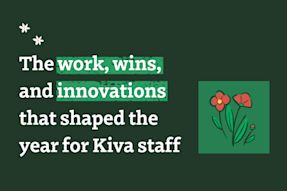April 14, 2021
The following is a transcript of an interview with Kiva Coordinators Nargiza Rajabova and Fazilat Beknazarova, who are currently based in Tajikistan and work with Micro Deposit Organization (MDO) Humo. Some of the responses have been edited for clarity and brevity.
Tell us a bit about yourself and how you ended up in your current role within Humo.
Nargiza Rajabova: I have been working with Humo for 11 years. I started working here in 2009 as a secretary to the General Director and worked in this role till 2013. I then became a Kiva Program Assistant after being recommended for the position. After a year and a half had gone by, I was offered the Kiva Coordinator position. I was made head of the department and am in charge of the department to this day.
Fazilat Beknazarova: I have been working in Humo for 6 years now. At first, I worked in a call center. After a year and a half, I was transferred over to the Kiva department. After helping out Nargiza and other women in the office, I quickly realized that I really liked the program and the project. I decided to stay, and have been working with Kiva for 4 ½ years now.
What were things like when Humo first began to work with Kiva? Did you encounter any resistance to the partnership?
Nargiza: Humo started to work with Kiva in 2007. Fazilat and I weren’t working with Humo yet at that time, so I asked my coworker about this. He said that there was no resistance to the Kiva partnership. At that time, Humo was a very small company and had a small budget to boot. Kiva helped us during that time by providing technical support and teaching us about how their funding operations worked.
What does your role within Humo currently involve on a daily basis?
Nargiza: The process involves receiving applications from the branch (which include photographs from clients as well as letters of consent to be featured on the Kiva website), accepting them if they meet the requirements, making a confirmation in the database, and then posting them onto Kiva the site. We have different designations for Kiva products that require our oversight before a loan is issued. For example, we have separate products for education, health, business, handicraft, etc. All of these loans require our special approval.
After that approval round, our branch offices can issue loans to borrowers. We also have other general loans that are first issued, then reviewed by experts afterward. If these loans meet our requirements, they are then sent to us and we check to see if the Kiva standards are upheld (photo matching, client consent, etc.). We then accept them and post them to the Kiva site. The process is generally the same.
Some of our loans are issued very quickly within the hour and do not require much monitoring. Some of these loans are actually Kiva loans! Each of these quick loans has a limit, though. If the amount is equal to or less than 10,000 somoni ($900 USD), they can be issued without monitoring. If those loan requirements are met within an hour, individuals automatically receive the loans.
How has your work and the work of Humo been impacted by COVID this year? How has Humo adapted to the new circumstances caused by the pandemic?
Nargiza: This year was very difficult and unpredictable for everyone all across the world. Humo adapted to any changes as well as it could. Sometime in March of 2020, when COVID was at its peak, Humo developed an anti-crisis action plan. Large loans were suspended and the issuance of microcredits was slightly reduced from the spring to the summer.
We also slightly changed the conditions of the deposits. Earlier on, customers could take their deposits back without a loss of interest after 2 months. That deadline was extended to 6 months in order to reduce the withdrawals of deposits. Also, the organization made a decision to restructure loans at the request of its clients whose businesses were temporarily closed.

Humo paid great attention to digital payments at this time. We began to inform people that they could make their payments through terminals or use their online wallet rather than asking them to come into the office and risk their safety.
In addition, sometime from April to July of 2020, the employees were divided into two groups. One group of employees continued to work and the other went on vacation. Most took vacation with pay. During quarantine, everyone was working remotely. Humo provided us with modems and internet access.
How has Tajikistan been impacted by COVID as a whole?
Nargiza: There is no more panic now. People are sick, but there is no longer such a stir. Things are calm, and everyone is doing their own thing. All markets, schools, and restaurants are open, but the borders of Tajikistan are closed. It’s business as usual.
To be honest, our government hasn’t announced any strict restrictions since the pandemic started. Masks are a must if you are in a crowded place, but even then many young people don’t take things seriously. The elderly are more or less serious about prevention because they are afraid, and you see less of them out and about.
Can you shed light on Tajikistan’s current economic state, and the unique challenges it faces in comparison to other former Soviet Union countries?
Nargiza: The economic situation in Tajikistan has deteriorated since the pandemic started. Tajikistan has a large number of emigrants in Russia that usually send money back to the country. This flow of remittances has decreased due to new restrictions in Russia. For example, many emigrants cannot find a job in Russian, and those that can are receiving less earnings. Naturally, this affects the economy and profitability of the country. We are very dependent on Russia.
Our national currency has also seen some devaluation. The dollar appreciated while the somoni fell, which influenced the prices of products. Everything has become much more expensive, and our salaries do not correspond to the new prices.
Another issue is that, because the borders of Tajikistan are closed, many emigrants could not leave in time to find work in Russia. They remain inside the country and are jobless, which also affects our population’s level of income. It has greatly fallen in comparison with previous years. We also have problems with attracting new capital and potential investors. They can’t come to Tajikistan and are postponing their travels until the situation improves.
Is microfinance benefitting the country? Has it spread widely and, if it hasn’t, what are the major blockers? How could the industry become more inclusive/be improved?
Nargiza: At the moment, we don’t have widespread online microcredit services like Europe or America do, where individuals can apply for credit electronically and do not have to physically travel to offices to certify things. If online loan issuance becomes available, more people will get access to microcredit. In essence, microfinance organizations need to pay more attention to their digital technology and innovate. It remains to be seen when the pandemic will end; things would be much easier and safer if we offered online services.

We have a huge number of branches. In addition to our branches, we have many banking service centers — 47 to be exact. In each region of the country, we have a branch, and each branch has its own points of service. These service points are mostly located in difficult-to-reach places. Most of our service points are in the countryside, although some are also located in cities. We are actually working on a few special projects with the Asian and European Development Bank, which typically caters to the agricultural sector.
In your opinion, what lessons or learnings can we (the microfinance industry) take away from 2020?
Nargiza: This year has shown the microfinance industry that it needs to move towards remote services in the field of digital technology. Our situation has pushed the sector to accelerate the transition to innovative digital technologies. For instance, Humo has launched an online loan in test mode since March 1, 2021. Online loans can be obtained through our Humo mobile wallet service in the amounts of 50 to 3000 somoni. The amount is determined by scoring. So far, this loan is only available to Humo staff. In the case of successful testing completion, the online loan feature will become available to all Humo clients.
Donate to Kiva today to support our work in spreading microfinance to countries like Tajikistan.
PREVIOUS ARTICLE
Celebrate April Fools' Day with Kiva →NEXT ARTICLE
Volunteer spotlight: “It’s really amazing to see how very similar we are despite our differences.” →














